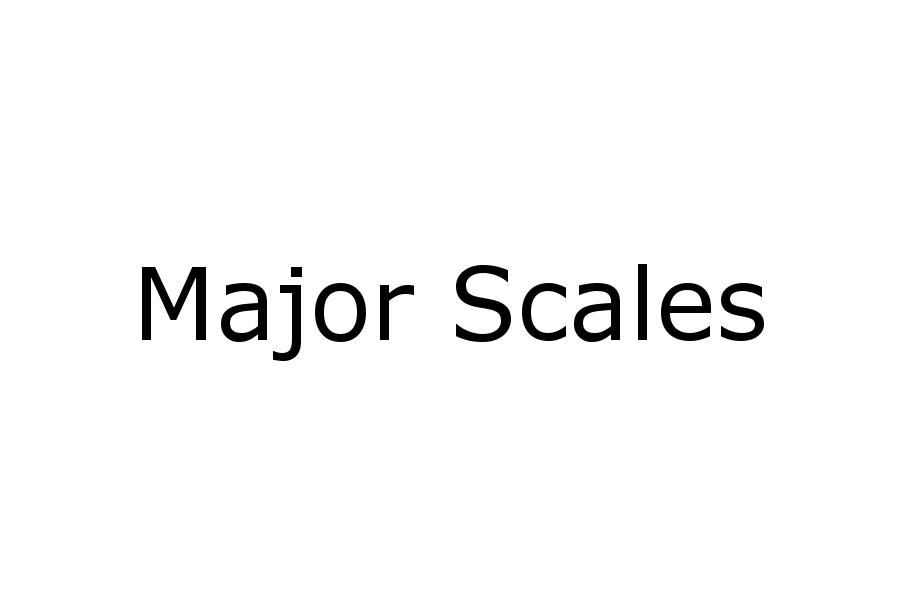Introduction to Major Scales

In this post I will give an introduction to major scales and show how to construct a major scale starting on any note. A major scale is identified by the first note of the scale which is known as the tonic. For example, the D major scale begins with the note D and the F major scale begins with the note F.
We will start by constructing the C major scale. As described above the C major scale begins with the note C and contains six other distinct pitches. The C major scale does not contain any accidentals so we can find the remaining six notes by starting at C and moving upward until we return to the note C. Thus we find that the C major scale consists of the following notes
C Major Scale
C, D, E, F, G, A, B
For those familiar with the piano we see that the notes of the C major scale correspond to the white keys on the piano. Now that we have our first example of a major scale we can construct a major scale which begins on any note. There are many ways this can be done but the key idea is to notice the pattern of intervals between the notes of a major scale.
The smallest distance between two notes in our standard tuning is called a semitone. For example, the distance between the notes E and F is a semitone because there is no other note between E and F. Notice that the distance between C and D is not a semitone because we can find the Note C# which lies between these two notes. Thus we will say that the distance between C and D is a whole tone because one note lies between them. A whole tone can be thought of as two semitones.
Using the concepts of whole tones and semitones we can find the pattern of a major scale. By looking at the C major scale we find that the distance between the notes in the scale are as follows
whole tone, whole tone, semitone, whole tone, whole tone, whole tone
We can use these distances to create a major scale on any note. Let us try to find the F major scale. The first note in the scale is F. Our second note should be a whole tone above F which is the note G. The third note is a whole tone about G which is the note A. The fourth tone is a semitone above A which is the note B-flat. By continuing is the manner we get the F major scale is the following sequence of notes
F Major Scale
F, G, A, B-flat, C, D, E
Notice that we had to add a flat to the note B in order to keep the proper distance between the third and fourth and the fourth and fifth notes of the scale. Let us try one more example by finding the D major scale. We start with the note D which is the tonic of the scale. The next note should be a whole tone above D which is the note E. The third note is a whole tone above E which is F#. By continuing in this manner we find the following notes for D major.
D Major Scale
D, E, F#, G, A, B, C#
By now it should be clear how to construct a major scale on any of the 12 notes using the pattern of whole tones and semitones from above. It is a good exercise to practice doing this on the more remote keys which contain a lot of sharps and flats.
In this post we have shown one method of constructing the major scale by using a pattern of whole tones and semitones. We have used this pattern to find the C major, F major, and D major scales. In another post we will use a similar idea to show how we can construct minor scales using a slightly different pattern of whole tones and semitones. This is slightly more complicated because there are three versions of the minor scale known commonly as the natural minor, harmonic minor and melodic minor scales.
References:
https://en.wikipedia.org/wiki/Major_scale
https://en.wikipedia.org/wiki/Semitone
Your post has been supported and upvoted from the Classical Music community on Steemit as it appears to be of interest to our community. You can find details about us below.
The classical music community at #classical-music and Discord.
Follow our community accounts @classical-music and @classical-radio.
Follow our curation trail (classical-radio) at SteemAuto
Thanks
A really wonderful education for the musician
A really successful teacher
Thank you
Congratulations! This post has been upvoted from the communal account, @minnowsupport, by timspeer from the Minnow Support Project. It's a witness project run by aggroed, ausbitbank, teamsteem, theprophet0, someguy123, neoxian, followbtcnews, and netuoso. The goal is to help Steemit grow by supporting Minnows. Please find us at the Peace, Abundance, and Liberty Network (PALnet) Discord Channel. It's a completely public and open space to all members of the Steemit community who voluntarily choose to be there.
If you would like to delegate to the Minnow Support Project you can do so by clicking on the following links: 50SP, 100SP, 250SP, 500SP, 1000SP, 5000SP.
Be sure to leave at least 50SP undelegated on your account.